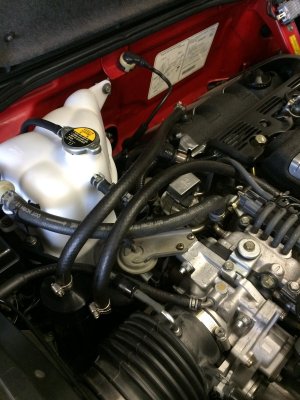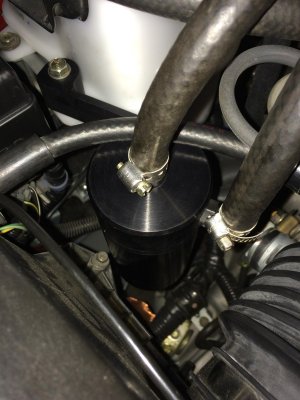Between the PCV gunk, EGR, dirt, throttle body cleaner and oversprayed K&N oil over the years, our early 1991-1994 NSX's all are in need of a serious intake manifold refresh. Since my engine was out for the head gasket repair, I took the manifold back home to do a little fall cleaning. My NSX has 90,000 miles and did have a K&N short ram intake on it for a while until I got smart and replaced with a stock airbox a few years ago.


This is the front side of my throttle body- cleaned in 2010 via the "LarryB" method. I did this after getting rid of the oily K&N and as you can see, 3 years later still nice and clean.


Now compare the rear side. Yuck! This goes to show why the only way to reliably clean the system is to remove it. Use liberal amounts of cleaner on the butterfly and inside the bore. Also make sure to squirt some cleaner in the small hole on the bottom left corner. This is the idle air passage. Let the fluid soak for 5 minutes and then blow out with compressed air.


After removing the rubber spacer, here is my intake. Nasty. Just shoot it with cleaner and wipe clean with a lint-free shop rag. Squirt cleaner into the PCV nipple, brake master nipple and the 4 small tubes on top of the intake. These are the vacuum control ports that are vital to many different systems on the NSX. You will not believe the black garbage that comes out of them. Spray compressed air to blow them out.





These are the various air ports that control a lot of stuff on the NSX. Make sure to clean out each one with a liberal amount of cleaner and blast with compressed air. Wipe any residue with a rag.


Here are the fast idle valve and EACV. The fast idle valve contains a thermowax pellet that is bathed in coolant flow from the engine. When cold, the valve is open and creates a vacuum leak to increase the RPM to 2,000. As the coolant warms up, the wax expands and lifts a plunger to seal the vacuum leak, leveling off to a normal idle speed of 850. The EACV is an electronic actuated plunger valve that is controlled by the ECU and introduces varying levels of vacuum leak to compensate for things like the A/C kicking on, etc. in order to hold a steady idle. Both rely on bleed air and both can get gummed up. Mine were filthy.


Fast idle valve cleaned and re-installed with new bolts, gaskets and top screws. Remove the top cover and spray carb cleaner into the top until it flows out of the bottom clear. Blow out with compressed air and let dry overnight. Make sure to use a new gasket when replacing the top cover. I also used new screws and lockwashers.


EACV cleaned with a new screen. I found the best way to install the new screen was to tap it in with a 13 mm deep socket and hammer. It is a press-fit so be careful not to bend or damage the screen. The old one was caked solid with black soot- explains why my NSX would die after starting sometimes. Clean in the same manner as the fast idle valve, keeping in mind the plunger seals the two chambers so you should spray and drain each port. Also take care not to let cleaner drain back into the solenoid. Again, a new gasket is a must.


Clean EACV back on the manifold with new bolts. Note clean fuel injector ports. Got them nice and shiny- they were caked with black goo.


Clean bottom pan. I s$%t you not- this had over 1 cup of motor oil floating in the bottom.


Clean manifold with new gasket installed.


VVIS check. All set screws confirmed swages are all 90 degree straight up and down and tight.


Last step. Fuel injectors are back from RC in Torrance. Nice and clean.


Test report. Looks like running Techron at every oil change isn't enough.


This is the front side of my throttle body- cleaned in 2010 via the "LarryB" method. I did this after getting rid of the oily K&N and as you can see, 3 years later still nice and clean.

Now compare the rear side. Yuck! This goes to show why the only way to reliably clean the system is to remove it. Use liberal amounts of cleaner on the butterfly and inside the bore. Also make sure to squirt some cleaner in the small hole on the bottom left corner. This is the idle air passage. Let the fluid soak for 5 minutes and then blow out with compressed air.

After removing the rubber spacer, here is my intake. Nasty. Just shoot it with cleaner and wipe clean with a lint-free shop rag. Squirt cleaner into the PCV nipple, brake master nipple and the 4 small tubes on top of the intake. These are the vacuum control ports that are vital to many different systems on the NSX. You will not believe the black garbage that comes out of them. Spray compressed air to blow them out.





These are the various air ports that control a lot of stuff on the NSX. Make sure to clean out each one with a liberal amount of cleaner and blast with compressed air. Wipe any residue with a rag.


Here are the fast idle valve and EACV. The fast idle valve contains a thermowax pellet that is bathed in coolant flow from the engine. When cold, the valve is open and creates a vacuum leak to increase the RPM to 2,000. As the coolant warms up, the wax expands and lifts a plunger to seal the vacuum leak, leveling off to a normal idle speed of 850. The EACV is an electronic actuated plunger valve that is controlled by the ECU and introduces varying levels of vacuum leak to compensate for things like the A/C kicking on, etc. in order to hold a steady idle. Both rely on bleed air and both can get gummed up. Mine were filthy.

Fast idle valve cleaned and re-installed with new bolts, gaskets and top screws. Remove the top cover and spray carb cleaner into the top until it flows out of the bottom clear. Blow out with compressed air and let dry overnight. Make sure to use a new gasket when replacing the top cover. I also used new screws and lockwashers.

EACV cleaned with a new screen. I found the best way to install the new screen was to tap it in with a 13 mm deep socket and hammer. It is a press-fit so be careful not to bend or damage the screen. The old one was caked solid with black soot- explains why my NSX would die after starting sometimes. Clean in the same manner as the fast idle valve, keeping in mind the plunger seals the two chambers so you should spray and drain each port. Also take care not to let cleaner drain back into the solenoid. Again, a new gasket is a must.

Clean EACV back on the manifold with new bolts. Note clean fuel injector ports. Got them nice and shiny- they were caked with black goo.

Clean bottom pan. I s$%t you not- this had over 1 cup of motor oil floating in the bottom.

Clean manifold with new gasket installed.

VVIS check. All set screws confirmed swages are all 90 degree straight up and down and tight.


Last step. Fuel injectors are back from RC in Torrance. Nice and clean.


Test report. Looks like running Techron at every oil change isn't enough.

Last edited:











